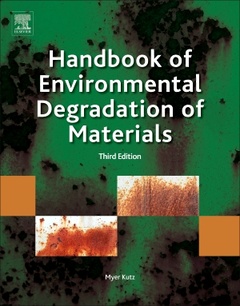Handbook of Environmental Degradation of Materials (3rd Ed.)
Auteur : Kutz Myer

The Handbook of Environmental Degradation of Materials, Third Edition, explains how to measure, analyze and control environmental degradation for a wide range of industrial materials, including metals, polymers, ceramics, concrete, wood and textiles exposed to environmental factors, such as weather, seawater, and fire. This updated edition divides the material into four new sections, Analysis and Testing, Types of Degradation, Protective Measures and Surface Engineering, then concluding with Case Studies. New chapters include topics on Hydrogen Permeation and Hydrogen Induced Cracking, Weathering of Plastics, the Environmental Degradation of Ceramics and Advanced Materials, Antimicrobial Layers, Coatings, and the Corrosion of Pipes in Drinking Water Systems.
Expert contributors to this book provide a wealth of insider knowledge and engineering expertise that complements their explanations and advice. Case Studies from areas such as pipelines, tankers, packaging and chemical processing equipment ensure that the reader understands the practical measures that can be put in place to save money, lives and the environment.
1. Analysis of Failures of Metallic Materails Due to Environmental Factors2. Laboratory Assessment of Corrosion3. Paint Weathering Tests4. Polymer Coatings for Concrete Surfaces: Testing and Modeling
Types of Degradation5. Electrochemical Corrosion6. High Temperature Oxidation7. Hydrogen Permeation and Hydrogen Induced Cracking8. Weathering of Plastics9. Thermal Degradation of Polymers and Polymer Composites10. Environmental Degradation of Ceramics11. Environmental Degradation of Engineered Nanomaterials12. Environmental Degradation of Reinforced Concrete13. Material Flammability14. Biofouling and prevention, and biodeterioration and biodegradation of materials
Protective Measures and Surface Engineering15. Cathodic Protection16. Thermal and Fire Protective Fabric Systems17. Protection of Wood-Based Materials18. Polymer Stabilization19. The Intersection of Design, Manufacturing, and Surface Engineering 20. Antimicrobial Layers and Coatings21. Protective Coatings for Aluminum Alloys22. Corrosion Resistant Coatings and Paints23. Thermal Spray Coatings
Case Studies24. Corrosion of Pipes in Drinking Water Systems25. Cathodic Protection for Pipelines26. Corrosion and Corrosion Protection in the Marine and Offshore Industries27. Barrier Packaging Materials28. Corrosion prevention and control programs for chemical processing equipment29. Degradation of Spacecraft Materials
- Introduces the reader to the effects of environmental degradation on a wide range of materials, including metals, plastics, concrete, wood and textiles
- Describes the kind of degradation that effects each material and how best to protect it
- Includes case studies that show how organizations, from small consulting firms, to corporate giants design and manufacture products that are more resistant to environmental effects
Date de parution : 06-2018
Ouvrage de 684 p.
21.4x27.6 cm
Thème de Handbook of Environmental Degradation of Materials :
Mots-clés :
Accelerated weathering; Advanced ceramics; Alkalinity; Alloy; Alloys corrosion; Alumina; Aluminum; Analysis; Analysis of failures; Anodic; Application methods; Applications; Barrier; Bioceramics; Biodeterioration; Biofilms; Biofouling; Blends; Bonding failure types; Bonding tests; Burning swatches; Cabinet exposure; Carbon nanotubes; Carbon steel; Catalyst; Cathodic; Cathodic protection; Chain stiffness; Chemical process; Chloride ingress; Classification of failures; Close packing; Coated concrete; Coated concrete failure criteria; Coating; Coatings; Coatings selection; Compartment fires; Composite materials; Composites; Computer fire modeling; Conversion; Copper; Correlation; Corrosion; Corrosion control; Corrosion fundamentals; Corrosion inhibitors; Corrosion of soda lime glass; Corrosion protection; Corrosion testing; Cotton; Crevice; Crosslinks; Crystallinity; Cultural heritage; Degradation; Design; Effects of combustion gases; Encapsulants; Engineering alloys; Environment; Environmental cracking; Environmental release; Environmental variables; Epoxy coatings; Equipment; Exposure process; Exterior spacecraft surfaces; Fiber; Fibers; Filler; Finishes; Fire-retardant; Flame retardant treatment; Flammability; Flashover; Food; Fouling; Fungi; Galvanic cathodic protection; Glass optical fibers; Glass transition temperature; Heat transfer modeling; Hemicellulose; High energy plasmas; Higher-strength steel; Hydrogen atom; Hydrogen damage; Hydrogen embrittlement; Hydrogen permeation; Hydrostatic test; Immersion; Impressed cathodic protection; Impressed current system; Inorganic carbon; Kevlar; Kinetics; LEO; Laboratory studies



